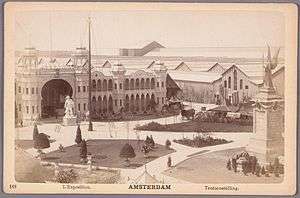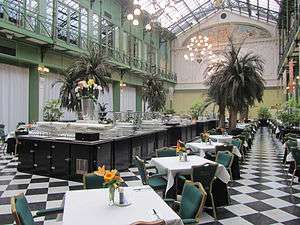International Colonial and Export Exhibition
The International Colonial and Export Exhibition (Dutch: Internationale Koloniale en Uitvoerhandel Tentoonstelling; French: Exposition Universelle Coloniale et d'Exportation Générale) was a colonial exhibition (a type of World's Fair) held in Amsterdam from May 1 to October 1, 1883. The event drew at least a million visitors and was the first international colonial exhibition, with 28 different nations presenting their colonial trade and wealth.



The event was the brainchild of Edouard Agostini, a French entrepreneur. Agostini, who had previously been involved in organizing the 1878 Exposition Universelle in Paris, presented his plans to the city of Amsterdam and King William III of the Netherlands in 1880. The Dutch government was initially hesitant, but Agostini managed to secure funding from Belgian and French investors.
The location chosen for the exhibition was an unused area of land behind the Rijksmuseum, which at that time was still under construction. This area is now Museumplein square. The main building was designed by the French architect Paul Fouquiau in "Moorish" style. It was constructed of wood covered with plaster and painted cloth, in order to give the impression of marble. Between the building's two large towers, a large cloth in "Indian" style was hung, with plaster heads of elephants and other animals. The building contained pavilions representing 28 different nations, including France, Germany, the United Kingdom, Belgium, Japan, the United States, China, Canada, the Ottoman Empire, Siam (Thailand), Transvaal, and the host country, the Netherlands.
Items on show in the main building included a telephone, wood- and metalworking machines, and a safe large enough to fit eight people. The building's colonial section presented products such as tobacco and rubber, as well as a reconstructed Javanese-style settlement (kampung) with "natives". At that time, it was not considered degrading or racist to put humans on display; in fact, it became a regularly featured spectacle at such exhibitions (see further: Human zoo).
Other structures included a music pavilion; the pavilion of the city of Amsterdam; the Dutch colonial pavilion; a Japanese bazar; various shops; and Dutch, English and German restaurants. In front of the Dutch colonial pavilion was a statue of Jan Pieterszoon Coen who, as governor-general of the Dutch East Indies, played a large part in the Dutch conquest of the Indonesian archipelago. A canal with a bamboo bridge and a Chinese junk intersected the exhibition grounds.
Effects
The exhibition, bringing more than a million visitors from around the world to Amsterdam, provided the city with a huge economic boost. A number of hotels were expanded or newly built in order to profit from the large number of visitors, including the Hotel Americain, the Doelen Hotel, and Hotel Krasnapolsky. The expansion of the Krasnapolsky included the glass-roofed Wintertuin lounge, with electric lighting, which at that time was considered a real novelty.
In Amsterdam, modern-day remains of the exhibition are the front gate of the Vondelpark and a collection of items in the Tropenmuseum which were on show in the Dutch colonial pavilion. Some items from the Dutch colonial pavilion were also donated to the ethnological museum of Artis zoo and, after this museum was closed, ended up in the Tropenmuseum as well. However, the lion's share of the thousands of items from this pavilion was donated to the National Museum of Ethnology in Leiden. Some parts of the German restaurant are now in the Veenkoloniaal Museum in Veendam.
Heineken still uses the label Diplôme d'Honneur on its beer bottles, an honour that was bestowed on the brewer at the 1883 colonial exhibition.
See also
- Colonial Exhibition of Semarang, a 1914 Colonial Exhibition in the Dutch East Indies
Further reading
- Alberdingk Thijm, J.A., "De waereldtentoonstelling van 1883", in: De Gids 1883, III, pp. 292-310. (Dutch)
- Bloembergen, Marieke, De koloniale vertoning; Nederland en Indië op de wereldtentoonstellingen (1880-1931). Amsterdam: Wereldbibliotheek, z.j. ISBN 90-284-1925-X (Dutch)
External links
| Wikimedia Commons has media related to International Colonial Exhibition. |